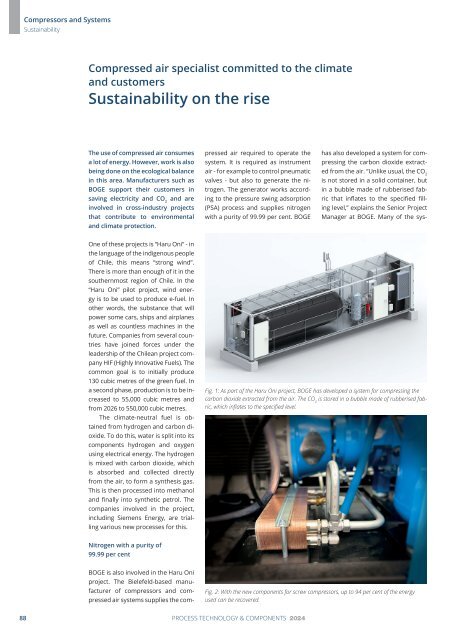PuK - Process Technology & Components 2024
A technical trade magazine with a history of more than 60 years.
A technical trade magazine with a history of more than 60 years.
You also want an ePaper? Increase the reach of your titles
YUMPU automatically turns print PDFs into web optimized ePapers that Google loves.
Compressors and Systems<br />
Sustainability<br />
Compressed air specialist committed to the climate<br />
and customers<br />
Sustainability on the rise<br />
The use of compressed air consumes<br />
a lot of energy. However, work is also<br />
being done on the ecological balance<br />
in this area. Manufacturers such as<br />
BOGE support their customers in<br />
saving electricity and CO 2<br />
and are<br />
involved in cross-industry projects<br />
that contribute to environmental<br />
and climate protection.<br />
BOGE is also involved in the Haru Oni<br />
project. The Bielefeld-based manufacturer<br />
of compressors and compressed<br />
air systems supplies the compressed<br />
air required to operate the<br />
system. It is required as instrument<br />
air - for example to control pneumatic<br />
valves - but also to generate the nitrogen.<br />
The generator works according<br />
to the pressure swing adsorption<br />
(PSA) process and supplies nitrogen<br />
with a purity of 99.99 per cent. BOGE<br />
has also developed a system for compressing<br />
the carbon dioxide extracted<br />
from the air. “Unlike usual, the CO 2<br />
is not stored in a solid container, but<br />
in a bubble made of rubberised fabric<br />
that inflates to the specified filling<br />
level,” explains the Senior Project<br />
Manager at BOGE. Many of the sys-<br />
One of these projects is “Haru Oni” - in<br />
the language of the indigenous people<br />
of Chile, this means “strong wind”.<br />
There is more than enough of it in the<br />
southernmost region of Chile. In the<br />
“Haru Oni” pilot project, wind energy<br />
is to be used to produce e-fuel. In<br />
other words, the substance that will<br />
power some cars, ships and airplanes<br />
as well as countless machines in the<br />
future. Companies from several countries<br />
have joined forces under the<br />
leadership of the Chilean project company<br />
HIF (Highly Innovative Fuels). The<br />
common goal is to initially produce<br />
130 cubic metres of the green fuel. In<br />
a second phase, production is to be increased<br />
to 55,000 cubic metres and<br />
from 2026 to 550,000 cubic metres.<br />
The climate-neutral fuel is obtained<br />
from hydrogen and carbon dioxide.<br />
To do this, water is split into its<br />
components hydrogen and oxygen<br />
using electrical energy. The hydrogen<br />
is mixed with carbon dioxide, which<br />
is absorbed and collected directly<br />
from the air, to form a synthesis gas.<br />
This is then processed into methanol<br />
and finally into synthetic petrol. The<br />
companies involved in the project,<br />
including Siemens Energy, are trialling<br />
various new processes for this.<br />
Fig. 1: As part of the Haru Oni project, BOGE has developed a system for compressing the<br />
carbon dioxide extracted from the air. The CO 2<br />
is stored in a bubble made of rubberised fabric,<br />
which inflates to the specified level.<br />
Nitrogen with a purity of<br />
99.99 per cent<br />
Fig. 2: With the new components for screw compressors, up to 94 per cent of the energy<br />
used can be recovered.<br />
88 PROCESS TECHNOLOGY & COMPONENTS <strong>2024</strong>

















